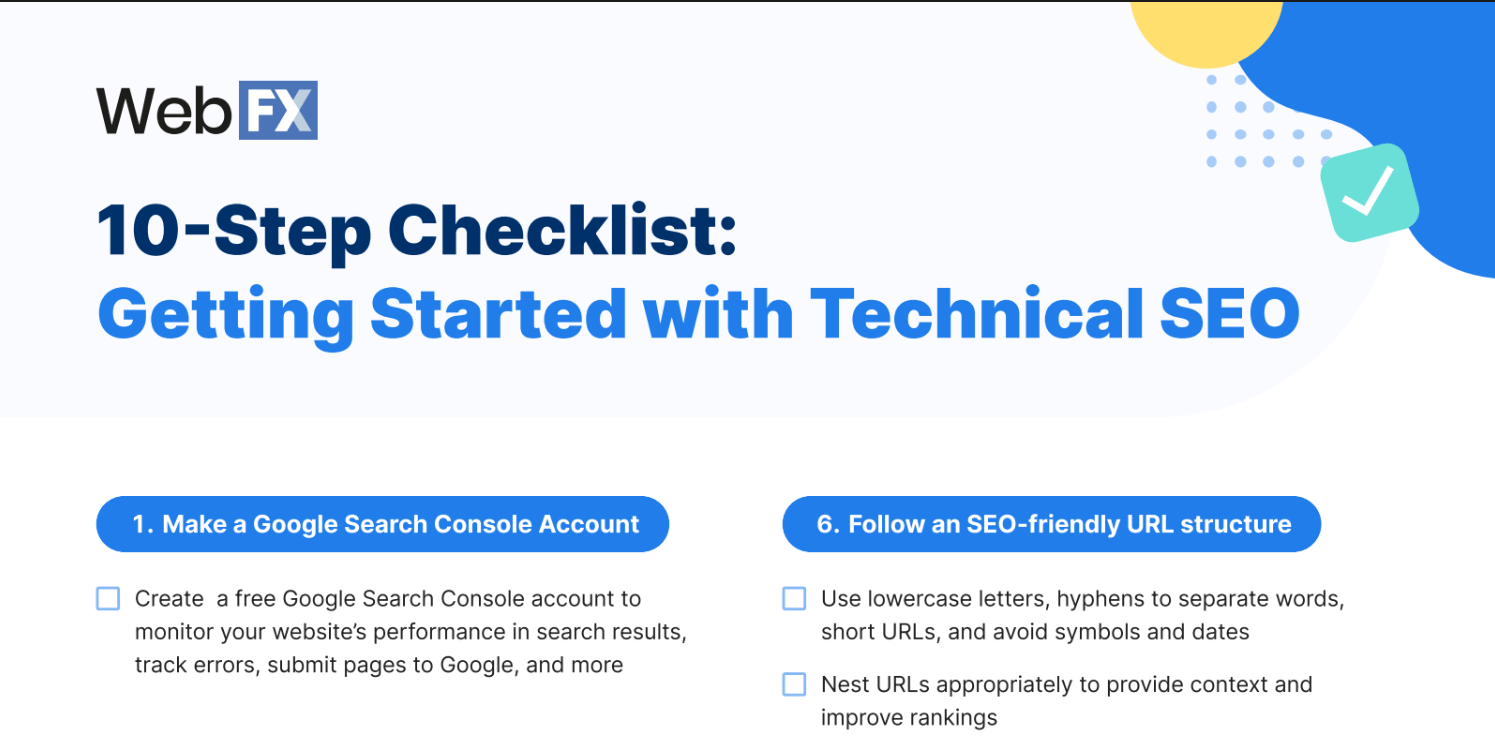-
 Published: Apr 1, 2025
Published: Apr 1, 2025
-
 15 min. read
15 min. read
-
 Sarah Berry
Sarah Berry Lead Web Marketing Consultant
Lead Web Marketing Consultant
- Sarah Berry is a Lead Web Marketing Consultant at WebFX. With more than 10,000 hours of experience, she offers practical insights and strategies you can use to grow your digital revenue. When she isn’t polishing her Time Magazine Person of the Year Award, she’s spending time with her flock of ducks.
What is technical SEO?
Technical SEO refers to backend website optimizations like page speed, internal links, and usability. These things help web crawlers (and web users) easily access, navigate, and understand your website, which can significantly boost your search rankings.
Technical SEO is a vital part of search engine optimization (SEO) — as vital as the peanut butter in a peanut butter and jelly sandwich. If you don’t optimize your website for technical SEO, you’ll hold your site back from ranking highly in search results.
In this guide, we’ll help you learn more about technical SEO by answering questions like:
- What is technical SEO?
- Why is technical SEO important?
- Technical SEO vs. on-page SEO vs. off-page SEO
- How to get started with technical SEO: A 10-step checklist
Keep reading to learn more about optimizing your technical SEO. And if you’re curious about the current state of your site’s technical SEO, use our free SEO checker to get an instant assessment!
Download Now: Free Technical SEO Checklist
What is technical SEO?
Technical SEO is a set of website and server optimizations that make your site easier for crawlers and website visitors to understand and use. Optimizing for technical SEO can help your business rank higher in search results because it creates a better user experience (UX) and leads to high-quality content.
Why is technical SEO important?
Your company should optimize your website’s technical SEO for a few reasons, including:
- Technical SEO boosts your rankings in search results
- Technical SEO impacts your website visitor’s actions and decisions
- Technical SEO increases your website’s conversion rate, lead generation, and sales
- Technical SEO helps your business keep up with competitors’ SEO
- Technical SEO maximizes your ROI from SEO as a digital marketing strategy
If you’re investing the time, energy, and money to manage your website’s SEO, you want to make sure you’re getting the most value from it. That requires you to incorporate a variety of technical SEO strategies into your strategy, whether you manage your SEO in-house or with the help of an SEO company.
Technical SEO vs. on-page SEO vs. off-page SEO
When talking about technical SEO’s definition, it’s helpful to distinguish it from on-page SEO and off-page SEO. Here’s a helpful chart outlining the difference between these three types of SEO:
| Type of SEO | Definition | Optimization Examples |
|---|---|---|
| Technical SEO | Focuses on backend website and server optimizations | Page speed, Internal linking, Sitemaps |
| On-Page SEO | Focuses on frontend website optimizations | Title tags, Content, Meta descriptions |
| Off-Page SEO | Focuses on optimizations outside your website | Link building, Social sharing, Guest blogging |
How to get started with technical SEO: A 10-step checklist
Are you ready to begin optimizing your website for technical SEO and reaping all the benefits of SEO, from higher rankings to better sales numbers? If so, you might be wondering how to get started. Fortunately, we’ve got your back.
Below is a helpful, 10-step technical SEO checklist you can follow to improve your site’s optimization. It provides a list of tips and action items for technical SEO, including:
- Make a Google Search Console account
- Create a robots.txt file
- Build an XML and HTML sitemap
- Use HTTPS
- Establish an SEO-friendly navigation setup
- Follow an SEO-friendly URL structure
- Develop a mobile-friendly website
- Optimize page speed
- Improve internal linking
- Add structured data to relevant pages
Read on to find out more about each of those steps.
1. Make a Google Search Console account
If you haven’t already, you should definitely create a Google Search Console account. Don’t worry — it’s free. Within Google Search Console, you can see your website’s overall performance in search results, as well as the performance of individual pages.
Plus, you can view errors that Google’s crawler (Googlebot) encounters when visiting your site. Since Google Search Console offers an inside look into how Google perceives your websites, it’s to your advantage to use this free tool. It can help you submit pages to Google, monitor Google rankings, fix Google crawling issues, and more.
Get started with Google Search Console by following our Google Search Console setup guide!
2. Create a robots.txt file
Next, you’ll want to create a robots.txt file. A robots.txt file serves as an instruction manual for web crawlers. You can even provide specific instructions for specific web crawlers, like those from Google or Bing.
Ideally, you’ll use these instructions to prevent crawlers from overwhelming your server with requests or from viewing unimportant pages. What you don’t want to do, however, is to block web crawlers from your entire website.
If you block web crawlers from your website, you’ll prevent search engines from indexing your site. That means your website won’t appear in search results, which means you’ll have a challenging time getting traffic to your site. The good news, however, is that Google helps you create an SEO-friendly robots.txt file.
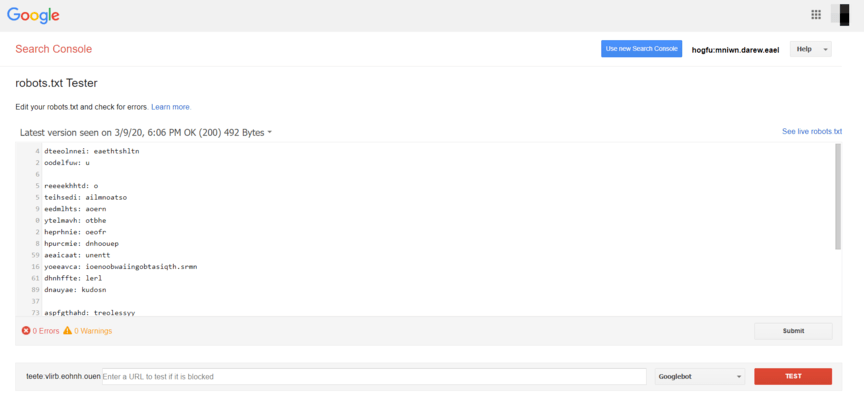
In addition to offering a quick guide on creating a robots.txt file, Google also offers a robots.txt test tool, which you can access when logged into your Google Search Console account. You can use this free tool to check your robots.txt file and ensure it provides the right instructions to web crawlers.
3. Build an XML and HTML sitemap
Besides creating a robots.txt file for your site, you’ll also want to build an XML and HTML sitemap. An XML sitemap serves as a map to your website, which crawlers use to find the most important pages, like your products or services, on your site. Users will not use an XML sitemap, but crawlers will, so it’s vital to getting your site indexed and ranked.
Creating an XML sitemap is easy, especially if you have a WordPress site. If your WordPress website uses the Yoast SEO plugin, for example, that plugin will build an XML sitemap for you.
Don’t have a WordPress site? No problem. Pick from the dozens of free XML sitemap generators, like Screaming Frog, to make your sitemap. Then submit your XML sitemap to Google via Google Search Console. Once you complete that part of this technical SEO checklist, move on to creating your HTML sitemap.
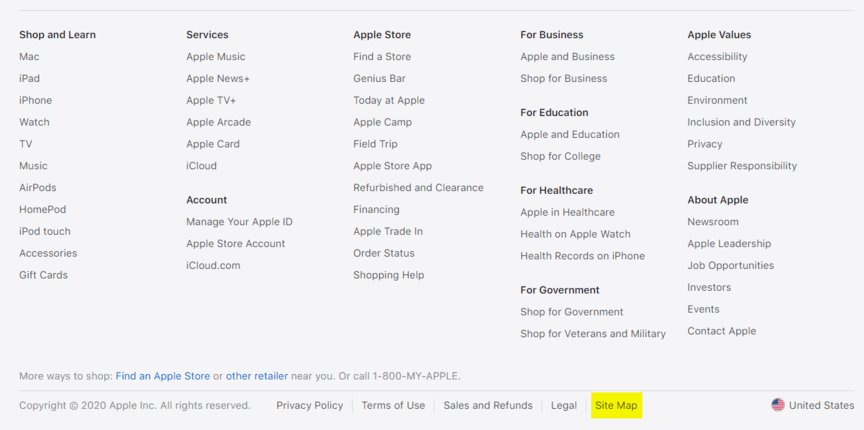
Both crawlers and human users will use your HTML sitemap. People can usually find HTML sitemaps when looking at the footer of a website or when arriving on a 404 page. These sitemaps help crawlers and users explore your website, which is why they’re helpful.
Generally, your sitemap will include the most important pages on your website (like general product or service pages), but it won’t have every single page on your site. If you do add all your website pages to your HTML sitemap, you’ll lessen the value of your sitemap to users. Look at Apple’s HTML sitemap as an example: 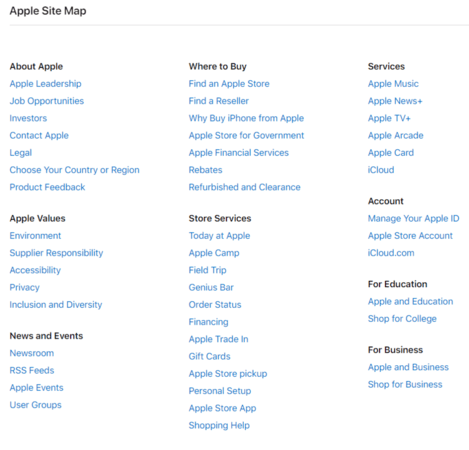 The company highlights a range of important pages, including:
The company highlights a range of important pages, including:
- Find an Apple Store
- Manage Your Apple ID
- Genius Bar
- And more
Ideally, you’ll want to keep your HTML sitemap to 100 pages or less. Remember, though, choose the most relevant and valuable pages. Don’t add 100 pages just because you can. Instead, add the most useful pages.
4. Use HTTPS
Go to your website and check your browser’s URL bar. Do you see a padlock or a “Not secure” message before your website’s URL?
If you don’t see a padlock, then you need to move your site from HTTP to HTTPS. HTTPS improves your website security by creating a secure connection that encrypts any data submitted by a user, like someone’s credit card information, email address, or phone number.
People do more shopping and communicating online, making HTTPS a must for any business. It’s worth noting that over 90% of all page loads occur over HTTPS.
You also want HTTPS because:
- Google uses HTTPS as a ranking factor, which means it can help you rank higher in search results
- Users reference the HTTPS padlock when shopping online, which can influence online sales
- HTTPS protects customer data, which helps your business protect its brand
Start moving from HTTP to HTTPS by purchasing a Secure Sockets Layer (SSL) certificate. Generally, SSL certificates cost around $0.80 to $125 per month. Depending on your website hosting provider, however, you may get an SSL certificate for free. Check with your hosting provider, and they can help you install the certificate.
If your website host doesn’t provide an SSL certificate, proceed with purchasing and installing your certificate yourself. In addition to the installation, you’ll need to set up the appropriate redirects from your HTTP to HTTPS pages.
For this step, get the help of someone experienced with SEO, like an SEO consultant. They can create the necessary redirects and will follow SEO best practices. Incorrect redirects can damage your SEO (and rankings) severely, which is why it’s so critical to create SEO-friendly redirects for HTTPS.
5. Establish an SEO-friendly navigation setup
Whether you have a small or large website, you’ll want to take a second look at your site’s navigation. Your navigation often describes your main navigation menu, which usually appears at the top or left-hand side of your website. In some cases, however, your business may have additional menus that people can use to find additional content.

For this technical SEO checklist, however, let’s focus on your main navigation menu and these best practices:
- Keep your main navigation to seven core menu items
- Make your main navigation menu the same across all pages
- Use keyword-rich anchor text for navigation items, like “Residential Landscaping Services”
- Organize menu items within sub-menus, if appropriate
When choosing which pages to feature on your main navigation, think about your most valuable pages. These often include product and service pages, as well as descriptive pages about your business and policies.
6. Follow an SEO-friendly URL structure
Technical SEO often focuses on the discoverability and usability of your website, which is why this technical SEO checklist includes a to-do that focuses on optimizing your site’s URL structure. If you want to make the most of SEO, follow these rules for your URLs:
- Use lowercase letters
- Separate words with hyphens
- Keep URLs short (most URLs will feature your target keyword)
- Avoid symbols (like “#” or “&”) and dates
In addition to these best practices, you’ll also want to nest your URLs appropriately.
For example, if you write an article, it makes sense to nest that article under a page that contains or houses informational resources. For example, let’s say you have the following URL:
www.example.com/example-article
A better approach might be to next that page under a broader topic, giving you the following URL:
www.example.com/resources/example-article/
Nesting your content like this can provide users, as well as crawlers, with context for your pages. They get the hint that what they’re viewing is likely an informational piece of content versus a sales-focused page.
That additional context can help search engines rank your content more appropriately, which gives you a better chance of ranking for your targeted keywords and reaching your target user.
Finally, make sure you’re formatting URLs consistently across your site. If you have different versions of pages (HTTP vs. HTTPS, for example, or www vs. non-www), use 301 redirects to send all traffic to the correct version and avoid being penalized for duplicate content.
7. Develop a mobile-friendly website
Every business needs a mobile-friendly website, especially for SEO. Google now follows a mobile-first index, which means it crawls and indexes your site from the perspective of a mobile user. If you don’t have a mobile-friendly site, your rankings will suffer. You can check and see if you have a mobile-friendly site using Google’s Lighthouse tool.
If you don’t have a mobile-friendly site, you’ll want to invest in responsive web design. Responsive web design makes your website friendly to all devices, from desktops to tablets to smartphones. It’s also a smarter and more cost-effective solution than building, maintaining, and optimizing a second mobile site. If you don’t have the resources to create a responsive website in-house, you can always invest in responsive web design services.
Some technical SEO agencies, like WebFX, offer responsive web design services so you can take care of your SEO and web design projects in one place. For more information about our services, check out our website maintenance pricing page. These services will help you launch a mobile- and SEO-friendly site on your preferred timeline.
Read More: Why Using a Mobile SEO Checker is Crucial
8. Optimize page speed
Page speed is an ongoing SEO optimization — and an essential one. When you optimize your site speed, you help your pages load faster. A faster load time means less waiting time for users. They can start reading your content and interacting with your page sooner, which increases their chances of staying on your site.
Ideally, you want pages to load in three seconds or less. If they take longer than that, you can expect 53% of users to leave your website. If you want to check the speed of your pages, use Google’s PageSpeed Insights tool.
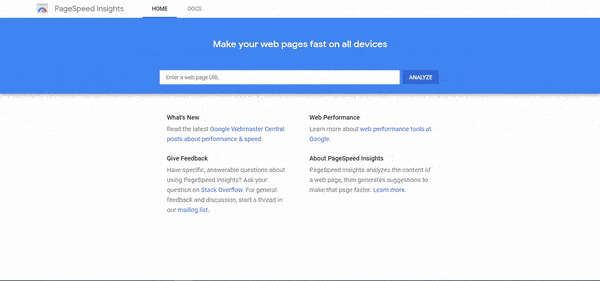
This tool will provide customized recommendations for how to improve your page speed. You can also follow several page speed best practices, which include:
- Compressing images, as well as HTML and JavaScript files
- Minifying CSS, HTML, and JavaScript
- Using browser caching
- Getting a content distribution network (CDN)
In most cases, you’ll need the help of a developer to review and implement these best practices. If you don’t have an in-house developer, you can always outsource the task via page speed optimization services. WebFX, for example, offers U.S.-based page speed optimization services. For more information about optimizing your page speed, check out our site speed checklist!
Try It Now: SEO.com Free SEO Checker
9. Improve internal linking
As your website grows, you’ll want to incorporate internal linking into your technical SEO strategy. Internal linking, like sitemaps and navigation menus, helps crawlers and users discover your content and stay on your site. Internal links also offer clues or context about a page’s focus and keyword targeting.
For example, take the following sentence, with the underline representing an internal link: “Before you start baking your first batch of cookies, make sure to get a good pair of oven mitts.” Based on the anchor text, “good pair of oven mitts,” you know the article relates to high-quality oven mitts in some way.
 In addition to using descriptive anchor text when linking between pages on your website, you also want to ensure every page on your site has internal links.
In addition to using descriptive anchor text when linking between pages on your website, you also want to ensure every page on your site has internal links.
When publishing content, for example, make it a part of your process to create three or more internal links to that new page. This approach will help crawlers find and index your content faster, plus provide helpful context.
You should also keep an eye out for broken links across your site. For example, a link might get formatted incorrectly, or the page it links to might be moved or deleted. Make sure to fix these links as you come across them, either by using redirects or by removing them altogether.
10. Add structured data to relevant pages
When it comes to technical SEO, structured data is another worthwhile investment of your time. Structured data is a type of markup that provides search crawlers with additional information about your page, like whether your page includes a recipe, a product, or a review.
In some cases, structured data can also generate an enhanced look for your page in search results, which users will see.
 The recipe markup, for example, will often generate the following information:
The recipe markup, for example, will often generate the following information:
- Cooking time
- Calories
- User rating
You can check whether pages use structured data with Google’s Structured Data Testing Tool.
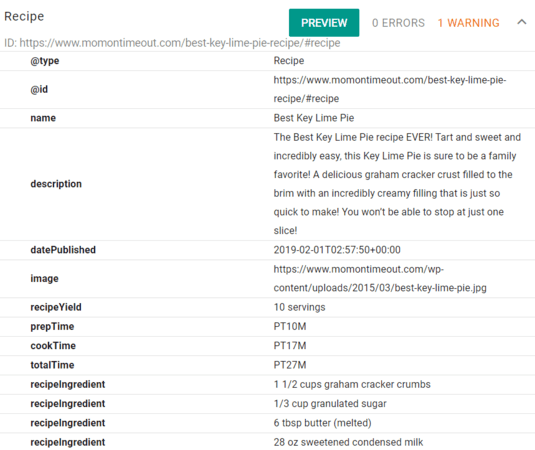
A range of structured data types are available, including:
- Recipe
- How-to
- Event
- Job posting
- Rating
- And more
If relevant to your page, add structured data. Use a free tool like Google’s Structured Data Markup Helper, for example, to mark up existing pages. This tool makes your work easy by allowing you to generate structured data by highlighting page elements, like price, rating, and more.
Once you finish marking up your page, check your work with Google’s Structured Data Testing Tool. If you have a WordPress site, the Yoast SEO plugin will add structured data for you.
Become a technical SEO expert
Are you looking to improve your knowledge of technical SEO? Join Revenue Weekly and receive technical SEO news, tips, and advice in your inbox. In addition, you can use our free SEO checker to monitor your progress and watch your website evolve to a leader in technical SEO.
And if you’re interested in getting help from a professional agency to optimize your technical SEO, WebFX has you covered. We have over 29 years of experience optimizing the technical aspects of clients’ websites to boost rankings, and we can do the same for you.
Interested in partnering with us? Just give us a call at 888-601-5359 or contact us online today!
-
 Sarah Berry is a Lead Web Marketing Consultant at WebFX. With more than 10,000 hours of experience, she offers practical insights and strategies you can use to grow your digital revenue. When she isn’t polishing her Time Magazine Person of the Year Award, she’s spending time with her flock of ducks.
Sarah Berry is a Lead Web Marketing Consultant at WebFX. With more than 10,000 hours of experience, she offers practical insights and strategies you can use to grow your digital revenue. When she isn’t polishing her Time Magazine Person of the Year Award, she’s spending time with her flock of ducks. -

WebFX is a full-service marketing agency with 1,100+ client reviews and a 4.9-star rating on Clutch! Find out how our expert team and revenue-accelerating tech can drive results for you! Learn more
Try our free Marketing Calculator
Craft a tailored online marketing strategy! Utilize our free Internet marketing calculator for a custom plan based on your location, reach, timeframe, and budget.
Plan Your Marketing Budget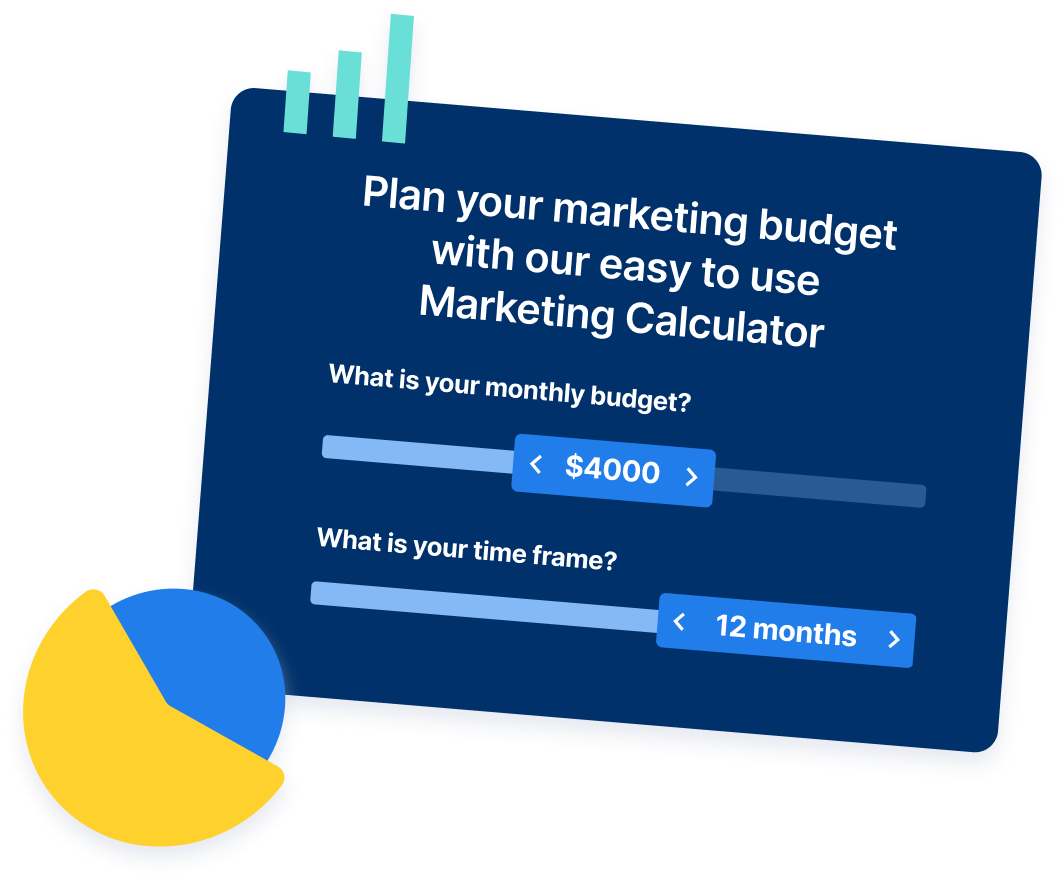
Table of Contents
- What is Technical SEO?
- Why is Technical SEO Important?
- Technical SEO vs. On-page SEO vs. Off-page SEO
- How to Get Started with Technical SEO: a 10-step Checklist
- 1. Make a Google Search Console Account
- 2. Create a Robots.txt File
- 3. Build an XML and HTML Sitemap
- 4. Use HTTPS
- 5. Establish an SEO-friendly Navigation Setup
- 6. Follow an SEO-friendly URL Structure
- 7. Develop a Mobile-friendly Website
- 8. Optimize Page Speed
- 9. Improve Internal Linking
- 10. Add Structured Data to Relevant Pages
- Become a Technical SEO Expert

SEO Success with KOA

Proven Marketing Strategies
Try our free Marketing Calculator
Craft a tailored online marketing strategy! Utilize our free Internet marketing calculator for a custom plan based on your location, reach, timeframe, and budget.
Plan Your Marketing Budget


